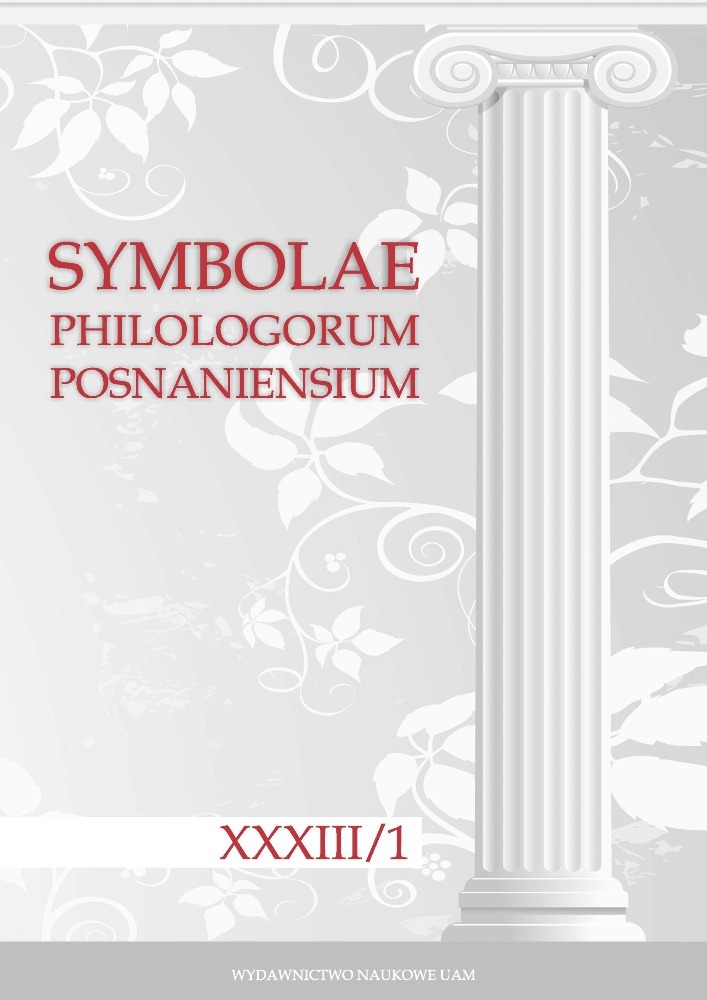Abstrakt
In the Etymological Dictionary of Akkadian, recently published, the noun pampallu ‘a garment or a woollen cloth’ is accompanied by a short note: “Of interest is a Phrygian word for a ‘coat’ (and the genitals) transmitted by Hesychios: βάμβαλον· ἱμάτιον· καὶ τὸ αἰδοῖον. Φρύγες”. The paper presents some other relevant data, especially Aristophanes’ fragment 791, attested in the lexicon of Photius: βάμβαλον· ἱμάτιον Βαβυλώνιον. οὕτως Ἀριστοφάνης – “bambalon: a Babylonian coat. Aristophanes [says] so”. The final result of the study is that there are two homonyms: 1. βάμβαλον ‘a Babylonian-style warm coat’, and 2. βά(μ)βαλον ‘genitals’. The former is a Semitic borrowing connected with the Akkadian pampallu, the latter is probably Phrygian, but its etymology remains
unknown.
Finansowanie
Artykuł powstał w ramach realizacji grantu Narodowego Centrum Nauki pt. Leksykon wyrazów orientalnych w języku starogreckim, nr UMO-2020/39/B/HS2/00934.
Bibliografia
Das sogenannte „Kyrill“-Lexikon in der Fassung der Handschrift E (Codex Bremensis G 11), ed. U. Hagedorn, Köln 2005, w: [https://kups.ub.uni-koeln.de/1813/].
Hesychii Alexandrini Lexicon, vol. I–II, eds. K. Latte, I.C. Cunningham, Berlin–Boston 2018–2020; vol. III, ed. P.A. Hansen, Berlin–New York 2005; vol. IV, eds. P.A. Hansen, I.C. Cunningham, Berlin–New York 2009.
Photii Patriarchae Lexicon, vol. I–III, ed. Ch. Theodoridis, Berlin–New York 1982–2013. DOI: https://doi.org/10.1515/9783110864069
Poetae comici Graeci, eds. R. Kassel, C. Austin, vol. III/2: Aristophanes, Testimonia et fragmenta, Berlin–New York 1984.
Babiniotis 2002: Γ. Μπαμπινιώτης, Λεξικό της νέας ελληνικής γλώσσας, 2. έκδ., Αθήνα 2002.
Bagordo 2017: A. Bagordo, Aristophanes fr. 675–820. Übersetzung und Kommentar, Heidelberg 2017.
Bai 2009: G. Bai, Semitische Lehnwörter im Altgriechischen, Hamburg 2009.
Beekes 2010: R. Beekes, Etymological Dictionary of Greek, with the assistance of L. van Beek, vol. I–II, Leiden–Boston 2010.
Black, George, Postgate 2000: J.A. Black, A. George, N. Postgate, A Concise Dictionary of Akkadian, 2nd ed., Wiesbaden 2000.
Brust 2008: M. Brust, Die indischen und iranischen Lehnwörter im Griechischen, 2. Aufl., Innsbruck 2008.
Campanile 1963: E. Campanile, Marginalia, „Studi e Saggi Linguistici” III (1963), 81–85.
Chantraine 1999: P. Chantraine, Dictionnaire étymologique de la langue grecque. Histoire des mots, Avec un Supplément sous la direction de A. Blanc et al., Paris 1999.
Conomis 1964: N.C. Conomis, Hesychiana, w: Miscellanea critica, vol. I, hrsg. J. Irmscher et alii, Leipzig 1964, 27–35.
Diakonoff , Neroznak 1985: I.M. Diakonoff, V.P Neroznak, Phrygian, Delmar 1985. DOI: https://doi.org/10.1017/CHOL9780521200912.002
Fick 1873: A. Fick, Phrygische Glossen, „Beiträge zur vergleichenden Sprachforschung auf dem Gebiete der arischen, celtischen und slawischen Sprachen” VII (1873), 358–384.
Frisk 1960–1972: H. Frisk, Griechisches etymologisches Wörterbuch, vol. I–III, Heidelberg 1960–1972.
Gelb et alii (eds.) 1956–2010: The Assyrian Dictionary of the Oriental Institute of the University of Chicago, eds. I.J. Gelb et. alii, vol. I–XXI, Chicago–Glückstadt 1956–2010.
Gusmani 1959: R. Gusmani, Studi frigi, Milano 1959.
Hamp 1990: E.P. Hamp, Varia, „Études celtiques” XXVII (1990), 179–189. DOI: https://doi.org/10.3406/ecelt.1990.1927
Kogan, Krebernik (eds.) 2020: Etymological Dictionary of Akkadian, eds. L. Kogan, M. Krebernik, vol. I, Boston–Berlin 2020.
Kukules 1955: Φ. Κουκουλές, Βυζαντινών βίος και πολιτισμός, τ. VI, Αθήνα 1955.
Masson 1967: É. Masson, Recherches sur les plus anciens emprunts sémitiques en grec, Paris 1967. DOI: https://doi.org/10.3406/ephe.1966.5089
Neroznak 1978: В.П. Нерознак, Палеобалканские языки, Москва 1978.
Obrador-Cursach 2020: B. Obrador-Cursach, The Phrygian Language, Leiden–Boston 2020. DOI: https://doi.org/10.1163/9789004419995
Persson 1912: P. Persson, Beiträge zur indogermanischen Wortforschung, vol. I–II, Uppsala 1912. DOI: https://doi.org/10.1515/angl.1912.1912.36.59
Pisani 1933: V. Pisani, Studi sulla preistoria delle lingue indeuropee, Torino 1933.
Pokorny 1959: J. Pokorny, Indogermanisches etymologisches Wörterbuch, Bern–München 1959.
Radner 2010: K. Radner, The Stele of Sargon II of Assyria at Kition: A Focus for an Emerging Cypriot Identity?, w: Interkulturalität in der Alten Welt: Vorderasien, Hellas, Ägypten und die vielfältigen Ebenen des Kontakts, hrsg. R. Rollinger et alii, Wiesbaden 2010, 429–449.
Robert 1963: L. Robert, Noms indigènes dans l’Asie Mineure gréco-romaine, vol. I, Paris 1963.
Rohde 1894: E. Rohde, Psyche. Seelencult und Unsterblichkeitsglaube der Griechen, Freiburg im Breisgau–Leipzig 1894.
Rosół 2013: R. Rosół, Frühe semitische Lehnwörter im Griechischen, Frankfurt am Main 2013. DOI: https://doi.org/10.3726/978-3-653-02022-9
Shipp 1979: G.P. Shipp, Modern Greek Evidence for the Ancient Greek Vocabulary, Sydney 1979.
Skoda 1982: F. Skoda, Le redoublement expressif: un universal linguistique. Analyse du procédé en grec ancien et en d’autres langues, Paris 1982.
von Soden 1981: W. von Soden, Akkadisches Handwörterbuch, vol. I–III, Wiesbaden 1965–1981.
Solmsen 1897: F. Solmsen, Thrakisch-Phrygisches, „Zeitschrift für vergleichende Sprachforschung” XXXIV (1897), 68–80.
Szemerényi 1974: O. Szemerényi, The Origins of the Greek Lexicon: Ex oriente lux, „Journal of Hellenic Studies” XCIV (1974), 145–157. DOI: https://doi.org/10.2307/630427
Walde, Pokorny 1927–1930: A. Walde, Vergleichendes Wörterbuch der indogermanischen Sprachen, hrsg. und bearb. J. Pokorny, vol. I–II, Berlin–Leipzig 1927–1930.


